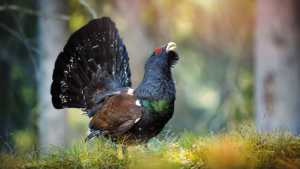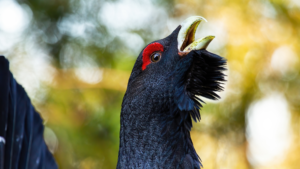Our scientists help the Capercaillie in the Vosges

© Milan Krasula
At the beginning of the twentieth century, there were more than 1,000 capercaillies, but by 2020 there were only 9 in the entire Vosges massif. While a reduction in the area of their habitat has contributed significantly to its disappearance, researchers believe that the high rate of inbreeding is now the main cause of its collapse. In order to reverse the trajectory and save them from extinction, the Ballons des Vosges Regional Nature Park has entrusted A Rocha with the task of studying scenarios for the release of capercaillie roosters to increase the genetic diversity of the population.
What has caused this disappearance?
The capercaillie is currently found in four mountain ranges in France: the Pyrenees, the Cévennes, the Vosges and the Jura. In 2018, there were 6,000 individuals, the vast majority in the Pyrenees. The populations of the Cévennes and Vosges, on the verge of extinction, number at best only a few dozen individuals, and the Jura population around 200.[1]
Several factors explain the disappearance of the species:
- the sharp decrease in the surface area of habitats favourable to the species and their fragmentation, often inherited from past forest management unsuited to the species
- excessive browsing (grazing of scrub and young trees by wild animals) by deer populations, which are expanding rapidly throughout France
- trophy hunting of roosters during the 20th century
- increased human use of the massifs, which has reached critical levels in the Vosges and the Jura
- obstacles such as ski lift cables or forest fences
- for a species adapted to the cold, global warming is also a factor
However, genetic studies[2] have shown that the very high level of inbreeding in the smallest populations, such as the Vosges, is also a very important factor, which can lead to a drop in reproductive success.
As part of the Vosges version of the National Action Plan for the Capercaillie, the Ballons des Vosges Regional Nature Park wanted to study the possibility of strengthening the genetic diversity of the population by releasing healthy cocks.
Without rapid intervention, the probability of extinction is very high
The 2021 counts indicate an even lower number of singing males than in 2020,[3] confirming the continuing decline of the population.
In partnership with the CNRS, the Groupe Tétras Vosges and the Office Français de la Biodiversité (OFB), our scientific director Timothée Schwartz first gathered and analysed the available demographic data on the species in order to build a viability model (a model that allows us to determine the risk of extinction of a population by simulating the potential trajectory of the population over time) simulating the dynamics of the cock population.

© wildmedia
13 capercaillie release scenarios studied
Thanks to the viability model, it is possible to compare scenarios based on different assumptions and to evaluate their impact on the population. Thus, we simulated 13 different release scenarios, based on the introduction of roosters from other wild populations, varying the number of individuals released, the release sites and the duration of the operation.
We tested the sensitivity of our model to different assumptions, such as a greater dispersion of the released individuals, a lower survival of the released individuals and a more or less improved reproduction by genetic reinforcement.
Genetic reinforcement clearly impacts population survival
Our modelling shows that all release scenarios would drastically reduce the probability of extinction of the population and that among the hypotheses tested, the genetic reinforcement hypothesis has the greatest impact on the viability of the population.
Not surprisingly, the greater the number of individuals released, the greater the effect on population size. Although our results do not allow us to certify that the population will maintain or increase, the introduction of capercaillie cocks can in any case buy time to save the Vosges population. It will also be necessary to continue to act on other levers, such as habitat quality, connectivity between sub-populations, and reducing disturbance and predation.
Based on the results of our work and a technical feasibility study conducted by the OFB, the Ballons des Vosges NRP has decided to implement a project to genetically reinforce the capercaillie population in the Vosges from 2023.
[1]Leclercq et Menoni (2018); [2]Westemeier (1998); Isomursu et al. (2012); Hammerly, Morrow, & Johnson (2013); Jacob & Foletti (2020); [3]Groupe Tétras Vosges.
